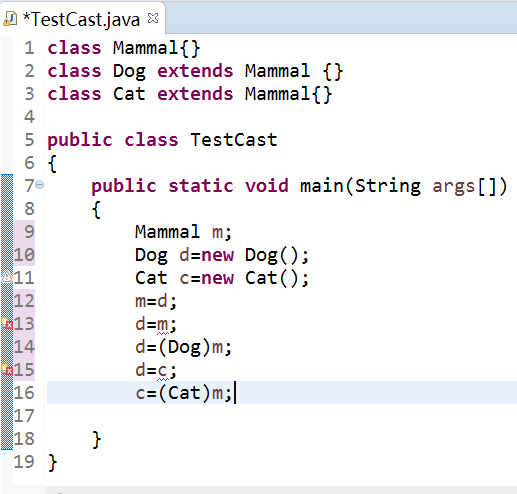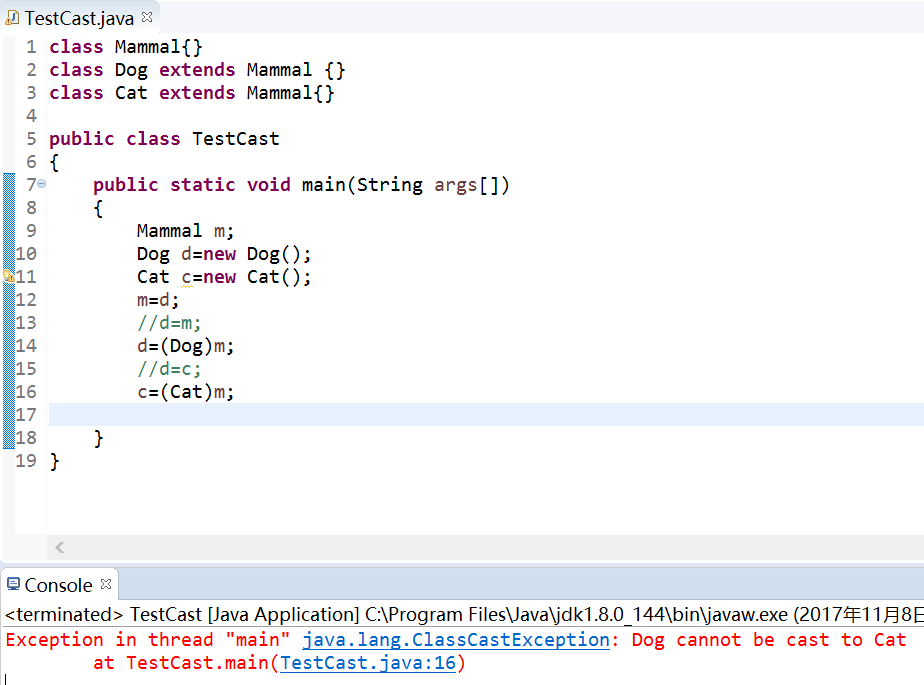1.怎样判断对象是否可以转换?
答:可以使用instanceof运算符判断一个对象是否可以转换为指定的类型:实例:
public class TestInstanceof
{
public static void main(String[] args)
{
//声明hello时使用Object类,则hello的编译类型是Object,Object是所有类的父类
//但hello变量的实际类型是String
Object hello = "Hello";
//String是Object类的子类,所以返回true。
System.out.println("字符串是否是Object类的实例:" + (hello instanceof Object));
//返回true。
System.out.println("字符串是否是String类的实例:" + (hello instanceof String));
//返回false。
System.out.println("字符串是否是Math类的实例:" + (hello instanceof Math));
//String实现了Comparable接口,所以返回true。
System.out.println("字符串是否是Comparable接口的实例:" + (hello instanceof Comparable));
String a = "Hello";
//String类既不是Math类,也不是Math类的父类,所以下面代码编译无法通过
//System.out.println("字符串是否是Math类的实例:" + (a instanceof Math));
}
}
程序运行结果:

2.现有三个类
class Mammal{}
class Dog extends Mammal{}
class Cat extends Mammal{}
先对其分别进行初始化:
Mammal m = null;
Dog d = new Dog();
Cat c = new Cat();
下列语句哪一个将引起编译错误?为什么?哪一个会引起运行时错误?为什么?
m = d;
d = m;
d = (Dog)m;
d = c;
c = (Cat)m;
事先判断结果:
出现编译错误:第二行,原因:不能将父类变量赋值给子类变量。
第四行,原因:继承于同一个父类的两个平行子类不能互相赋值。
出现运行错误:第五行,原因:在第一行中,m变量已经指向Dog对象,如果再执行c = (Cat)m,就是让c指向Dog对象,而Cat和Dog之间不存在继承关系,无法让c指向Dog对象。
程序编译截图:

测试截图:

结论:
对象之间互相赋值时,子类对象可以对父类对象赋值,父类对象不能对子类变量赋值,继承与同一基类的平行子类之间不能相互赋值。
3.运行以下测试代码:
public class ParentChildTest {
public static void main(String[] args) {
Parent parent=new Parent();
parent.printValue();
Child child=new Child();
child.printValue();
parent=child;
parent.printValue();
parent.myValue++;
parent.printValue();
((Child)parent).myValue++;
parent.printValue();
}
}
class Parent{
public int myValue=100;
public void printValue() {
System.out.println("Parent.printValue(),myValue="+myValue);
}
}
class Child extends Parent{
public int myValue=200;
public void printValue() {
System.out.println("Child.printValue(),myValue="+myValue);
}
}
1)上边的程序的运行结果是什么?
运行结果如图:

总结:
子类可以赋值给父类,代表父类变量引用子类的对象。子类可以覆盖父类,覆盖后引用的是子类的方法,如果需要引用父类的方法可以用super函数。当子类与父类拥有一样的方法,并且让一个父类变量引用一个子类对象时,到底调用哪个方法,由对象自己的“真实”类型所决定,这就是说:对象是子类型的,它就调用子类型的方法,是父类型的,它就调用父类型的方法。这个特性实际上就是面向对象“多态”特性的具体表现。如果子类与父类有相同的字段,子类方法中访问的是子类中的字段(而不是父类中的字段)。如果子类方法确实想访问父类中被隐藏的同名字段,可以用super关键字来访问它。如果子类被当做父类使用,则通过子类访问的字段是父类的。
